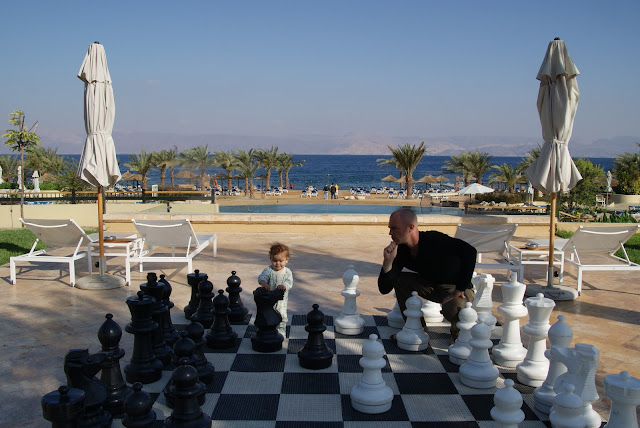 Why is the Red Sea called the "Red" Sea, I wondered, as I peered out over its vast blue expanse while Charlie thrashed Dave at a game of chess.
Why is the Red Sea called the "Red" Sea, I wondered, as I peered out over its vast blue expanse while Charlie thrashed Dave at a game of chess. Is it because of the reddish mountains that surround it? (You can see the mountains on the Egyptian shoreline in this photo to the right.) Or the red sand of its shores?
 I turned to my trusty friend wikipedia on return to Amman, and found no definitive answer. Wiki, in all its sage wisdom, advises:
I turned to my trusty friend wikipedia on return to Amman, and found no definitive answer. Wiki, in all its sage wisdom, advises:* The name of the sea may signify the seasonal blooms of the red-coloured Trichodesmium erythraeum near the water's surface.
* Another hypothesis is that the name comes from the Himyarite, a local group whose own name means red.
* A theory favored by some modern scholars is that the name red is referring to the direction South, just as the Black Sea's name may refer to North. The basis of this theory is that some Asiatic languages used color words to refer to the cardinal directions. Herodotus on one occasion uses Red Sea and Southern Sea interchangeably.
* It is theorized that it was named so because it borders the Egyptian Desert, which the ancient Egyptians called the Dashret or "red land"; therefore it would have been the sea of the red land.

 At least my theory was one of the options. What I loved about our trip to Aquaba, which is the Jordanian city that has access to the Red Sea, is that we were right on the borders of Saudi Arabia, Israel and Egypt. I kept pointing out the different countries to Dave. "See those hills over there - that's Egypt. Hear that doof doof music? Yep, that's Israel." Here's a map so you can see that Aquaba (in the red circle) is indeed at an awesome junction of Middle East borders. After Friday night in Aquaba and many swims for Charlie, and a bit of rock climbing training, we headed to Wadi Rum, the rock climber's mecca. It's also well known for its connection with British officer, T.E.Lawrence, otherwise known as Lawrence of Arabia, who set up his base there during the Arab Revolt of 1917-18. Wadi Rum went on to play another important part in Jordan's history when King Hussein met his English wife there, while she was working as a secretary on the film set of Lawrence of Arabia.
At least my theory was one of the options. What I loved about our trip to Aquaba, which is the Jordanian city that has access to the Red Sea, is that we were right on the borders of Saudi Arabia, Israel and Egypt. I kept pointing out the different countries to Dave. "See those hills over there - that's Egypt. Hear that doof doof music? Yep, that's Israel." Here's a map so you can see that Aquaba (in the red circle) is indeed at an awesome junction of Middle East borders. After Friday night in Aquaba and many swims for Charlie, and a bit of rock climbing training, we headed to Wadi Rum, the rock climber's mecca. It's also well known for its connection with British officer, T.E.Lawrence, otherwise known as Lawrence of Arabia, who set up his base there during the Arab Revolt of 1917-18. Wadi Rum went on to play another important part in Jordan's history when King Hussein met his English wife there, while she was working as a secretary on the film set of Lawrence of Arabia.  On the way to Wadi Rum, I was delighted to see many street signs warning of random camels crossing the road. So I had to stop and photograph the sign much like an European has to photograph a kangaroo sign in Australia. And then we had to chase some camels down the road to show Charlie (Dave is holding her in the picture below but you can't tell). Wadi Rum is amazing. I'll let the pictures do the talking of ancient Nabataen rock inscriptions, cliff hanger moments and encounters with lovely old Bedouin men.
On the way to Wadi Rum, I was delighted to see many street signs warning of random camels crossing the road. So I had to stop and photograph the sign much like an European has to photograph a kangaroo sign in Australia. And then we had to chase some camels down the road to show Charlie (Dave is holding her in the picture below but you can't tell). Wadi Rum is amazing. I'll let the pictures do the talking of ancient Nabataen rock inscriptions, cliff hanger moments and encounters with lovely old Bedouin men. 










beautiful! and so close to your home!
ReplyDeleteLove the pics but put some of Dave conquering some sick overhangs next time please :D
My lord - no wonder it's known for it's climbing - check out those cliffs! All I could think was looking at the pics was, what an amazing experience. So different to what we know... All Locke was thinking was, *sigh, look into the distance* Charlie just gets more and more beautiful everyday :) xox
ReplyDeleteWow, amazing!! What a beautiful place :)
ReplyDelete